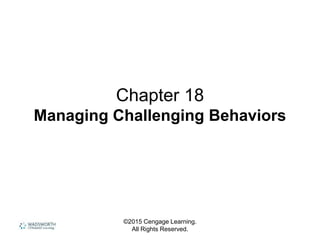
Allen Chapter18
- 1. ©2015 Cengage Learning. All Rights Reserved. Chapter 18 Managing Challenging Behaviors
- 2. ©2015 Cengage Learning. All Rights Reserved. When is a Behavior a Problem? • Most children exhibit mood swings. • Most children have had at least one tantrum. • Children have off days. • Normal deviations become fixed patterns when they get the adult attention.
- 3. ©2015 Cengage Learning. All Rights Reserved. When is a Behavior a Problem? (continued) • Temperament – Goodness of fit. – Caregivers and children need to fit each other. – Active children need caregivers who respect and appreciate the child’s need to move. – Quiet children need a caregiver who understands their need for more one-on-one time.
- 4. ©2015 Cengage Learning. All Rights Reserved. When is a Behavior a Problem? (continued) • How much is too much? – Occasional outbursts are not a concern. – Behaviors that increase in intensity need a second look. – How much is too much of a behavior? – Observation will be the key.
- 5. ©2015 Cengage Learning. All Rights Reserved. A Tiered Framework for Intervention • Building positive relationships • Preventative classroom interventions • Social emotional teaching strategies • Planning intensive individualized interventions
- 6. ©2015 Cengage Learning. All Rights Reserved. A Tiered Framework for Intervention (continued) • Designing interventions – Positive behavior support • Identify the behavior. • Identify the settings in which it occurs. • Design interventions with which all team members are comfortable.
- 7. ©2015 Cengage Learning. All Rights Reserved. A Functional Approach to Managing Problem Behaviors • A functional approach to managing problem behaviors – Examine the environment. – Examine your own behaviors. – Use a functional behavior assessment.
- 8. ©2015 Cengage Learning. All Rights Reserved. A Functional Approach to Managing Problem Behaviors (continued) • Steps to a functional behavior assessment: – Identify the problem situation. – Assess the child and the environment. – Specify an objective for the intervention. – Assess the function of the behavior. – Identify a replacement behavior. – Plan the intervention.
- 9. ©2015 Cengage Learning. All Rights Reserved. A Functional Approach to Managing Problem Behaviors (continued) – Implement the plan and ensure that it is carried out as planned. – Monitor the child’s progress and continue to monitor implementation.
- 10. ©2015 Cengage Learning. All Rights Reserved. Data Collection and Monitoring Progress • Types of data collection – Frequency—number of times a behavior occurs. – Duration—how long each episode occurs. – Interval—breaking the day up into intervals and evaluating when the behavior occurs.
- 11. ©2015 Cengage Learning. All Rights Reserved. Data Collection and Monitoring Progress (continued) • Collecting data – Record a baseline—observe the child three to five days before intervention. – Frequency methods. – Duration methods. – Interval methods.
- 12. ©2015 Cengage Learning. All Rights Reserved. Common Behavior Problems and Solutions • Aggressiveness – Conflict—seeing what triggers the behavior. – Managing aggressiveness—watching for the triggers, eliminating them, teaching appropriate responses to emotions.
- 13. ©2015 Cengage Learning. All Rights Reserved. Common Behavior Problems and Solutions (continued) • Disruptive and destructive behaviors – Need for attention – challenging behavior gains attention. – Mastering routines – not understanding or mastering classroom routines. – Redirection – gentle reminders of expected behavior. – Time-out – break the pattern of responses.
- 14. ©2015 Cengage Learning. All Rights Reserved. Common Behavior Problems and Solutions (continued) • Noncompliance – Prevention strategies • Advance warnings. • Reduce overload. • Make requests and give directions clearly and briefly. • Provide choices. • Beware of choices that are not choices • Focus the child’s attention
- 15. ©2015 Cengage Learning. All Rights Reserved. Common Behavior Problems and Solutions (continued) • Allow time to comply • Practice consistency and firmness • Make sound judgments
- 16. ©2015 Cengage Learning. All Rights Reserved. Common Behavior Problems and Solutions (continued) • Temper tantrums – Tantrums are a child’s try at control over adults. – Children learn that they need to tantrum longer to break down the adults. – Management of tantrums • Consistency • Safety • Identification of underlying causes
- 17. ©2015 Cengage Learning. All Rights Reserved. Common Behavior Problems and Solutions (continued) • Separation problems – Children experience separation problems as a developmental milestone. – Consistency in routine and caregivers is important. – It will pass, but children need to know that they can trust what is in their environment.
- 18. ©2015 Cengage Learning. All Rights Reserved. Common Behavior Problems and Solutions (continued) • Overdependence – Children are clingy to a teacher or parent. – Teacher needs to walk a fine line: • Too little attention, child feels rejected. • Too much attention, child’s behavior increases.
- 19. ©2015 Cengage Learning. All Rights Reserved. Common Behavior Problems and Solutions (continued) • Withdrawal – Withdrawn children do not draw the teacher’s attention. – They can retreat even further from social situations.
- 20. ©2015 Cengage Learning. All Rights Reserved. Common Behavior Problems and Solutions (continued) – Questions to ask • Does the child engage in activities? • Do the materials interest the child? • Does the child spend time watching other children? • Is the child likely to leave an activity if certain children approach? • Does the child play close to some children?
- 21. ©2015 Cengage Learning. All Rights Reserved. Common Behavior Problems and Solutions (continued) • Inability to share – To aid children in learning this skill: • Provide multiples of materials. • Interest centers should be attractive. • Encourage a gamelike atmosphere.
- 22. ©2015 Cengage Learning. All Rights Reserved. Common Behavior Problems and Solutions (continued) • The family’s involvement – Central role in addressing challenging behavior. – Culture influences differences in agreement about what is considered a challenge or problem behavior.
